Complete Solutions to SECTION-A (READING) of chapter QUESTION PAPER 2022 TERM 1 SET 1 of Class 12 book with complete answers and questions
| Class 12 | ENGLISH |
| Chapter | QUESTION PAPER 2022 TERM 1 SET 1 |
| XII BOARDS PREVIOUS YEAR | SECTION-A (READING) |
| Number Of Questions | 19 |
| Academic Year | 2023-24 |
Read the passage given below
1. What's the one thing that you associate with your college days ? For me, it was consuming copious amounts of chai. A cup of tea was a panacea to all troubles and the companion to all joys. In this exclusive interview, we caught up with 65-year-old Deepak Garg, owner of Ganga Dhaba, a spot that every officer from National Academy of Administration has visited multiple times.
2. Deepak begins, "My family has been here for almost 90 years. It was my grandfather who first started working here the supplier to the hotel that existed then. "In 1964, when Deepak was all of eight, he lost his father and the responsibility of raising four children, fell on his mother.
3. "Our growing up years were hugo struggle. My mother used to teach home science at a local balwadi school, and which was also where my siblings and I studied", he says. In 1978, Deepak says that he started a food joint that he named Om Chinese restaurant. "In those days, there was a huge liking for Chinese food and hence the name and the choice of cuisine," he says.
4. For almost 17 years, things continued and then Deepak got a Public Call Office (PCO) installed for the Officer Trainees. The business did so well that soon he had installed more than ten telephones, with separate cabins, to allow them some privacy while they made and received their calls.
5. "The Ots who would talk on the PCO from here would always refer to the place as Ganga Dhaba". It was because this place is so close to the Ganga hostel inside the academy, that slowly the name changed and it became Ganga Dhaba. "Since it was the OTs that gave us our identity, we decided to change the name and call it Ganga Dhaba," he says.
6. There have been instances when Deepak and his family members have learnt dishes from the OTs. He says, "So many dishes on our menu today are because some officer came in and decided to teach us how to make them" .
7. We have seen two generations of officers, served the parents, who now as the parents come back to drop their children at the academy and tell us to take care of them. What more can we ask for? While the money we make is not great, the respect and the love we have accumulated over the years is what keeps us going," says Deepak, proudly.
Based on your understanding of the passage, answer any eight out of the ten questions by choosing the correct options :
What, according to the author, gave him solace during his bad times in his college days?
View SolutionRead the passage given below
1. What's the one thing that you associate with your college days ? For me, it was consuming copious amounts of chai. A cup of tea was a panacea to all troubles and the companion to all joys. In this exclusive interview, we caught up with 65-year-old Deepak Garg, owner of Ganga Dhaba, a spot that every officer from National Academy of Administration has visited multiple times.
2. Deepak begins, "My family has been here for almost 90 years. It was my grandfather who first started working here the supplier to the hotel that existed then. "In 1964, when Deepak was all of eight, he lost his father and the responsibility of raising four children, fell on his mother.
3. "Our growing up years were hugo struggle. My mother used to teach home science at a local balwadi school, and which was also where my siblings and I studied", he says. In 1978, Deepak says that he started a food joint that he named Om Chinese restaurant. "In those days, there was a huge liking for Chinese food and hence the name and the choice of cuisine," he says.
4. For almost 17 years, things continued and then Deepak got a Public Call Office (PCO) installed for the Officer Trainees. The business did so well that soon he had installed more than ten telephones, with separate cabins, to allow them some privacy while they made and received their calls.
5. "The Ots who would talk on the PCO from here would always refer to the place as Ganga Dhaba". It was because this place is so close to the Ganga hostel inside the academy, that slowly the name changed and it became Ganga Dhaba. "Since it was the OTs that gave us our identity, we decided to change the name and call it Ganga Dhaba," he says.
6. There have been instances when Deepak and his family members have learnt dishes from the OTs. He says, "So many dishes on our menu today are because some officer came in and decided to teach us how to make them" .
7. We have seen two generations of officers, served the parents, who now as the parents come back to drop their children at the academy and tell us to take care of them. What more can we ask for? While the money we make is not great, the respect and the love we have accumulated over the years is what keeps us going," says Deepak, proudly.
Based on your understanding of the passage, answer any eight out of the ten questions by choosing the correct options :
Read the following statements :
(i) Mr. Deepak named his food joint Om Chinese.
(ii) Chinese food was then popular among people.
View SolutionRead the passage given below
1. What's the one thing that you associate with your college days ? For me, it was consuming copious amounts of chai. A cup of tea was a panacea to all troubles and the companion to all joys. In this exclusive interview, we caught up with 65-year-old Deepak Garg, owner of Ganga Dhaba, a spot that every officer from National Academy of Administration has visited multiple times.
2. Deepak begins, "My family has been here for almost 90 years. It was my grandfather who first started working here the supplier to the hotel that existed then. "In 1964, when Deepak was all of eight, he lost his father and the responsibility of raising four children, fell on his mother.
3. "Our growing up years were hugo struggle. My mother used to teach home science at a local balwadi school, and which was also where my siblings and I studied", he says. In 1978, Deepak says that he started a food joint that he named Om Chinese restaurant. "In those days, there was a huge liking for Chinese food and hence the name and the choice of cuisine," he says.
4. For almost 17 years, things continued and then Deepak got a Public Call Office (PCO) installed for the Officer Trainees. The business did so well that soon he had installed more than ten telephones, with separate cabins, to allow them some privacy while they made and received their calls.
5. "The Ots who would talk on the PCO from here would always refer to the place as Ganga Dhaba". It was because this place is so close to the Ganga hostel inside the academy, that slowly the name changed and it became Ganga Dhaba. "Since it was the OTs that gave us our identity, we decided to change the name and call it Ganga Dhaba," he says.
6. There have been instances when Deepak and his family members have learnt dishes from the OTs. He says, "So many dishes on our menu today are because some officer came in and decided to teach us how to make them" .
7. We have seen two generations of officers, served the parents, who now as the parents come back to drop their children at the academy and tell us to take care of them. What more can we ask for? While the money we make is not great, the respect and the love we have accumulated over the years is what keeps us going," says Deepak, proudly.
Based on your understanding of the passage, answer any eight out of the ten questions by choosing the correct options :
'Soon he had installed ten telephones.'
In the light of the above statement select the option that lists the right inference.
View SolutionRead the passage given below
1. What's the one thing that you associate with your college days ? For me, it was consuming copious amounts of chai. A cup of tea was a panacea to all troubles and the companion to all joys. In this exclusive interview, we caught up with 65-year-old Deepak Garg, owner of Ganga Dhaba, a spot that every officer from National Academy of Administration has visited multiple times.
2. Deepak begins, "My family has been here for almost 90 years. It was my grandfather who first started working here the supplier to the hotel that existed then. "In 1964, when Deepak was all of eight, he lost his father and the responsibility of raising four children, fell on his mother.
3. "Our growing up years were hugo struggle. My mother used to teach home science at a local balwadi school, and which was also where my siblings and I studied", he says. In 1978, Deepak says that he started a food joint that he named Om Chinese restaurant. "In those days, there was a huge liking for Chinese food and hence the name and the choice of cuisine," he says.
4. For almost 17 years, things continued and then Deepak got a Public Call Office (PCO) installed for the Officer Trainees. The business did so well that soon he had installed more than ten telephones, with separate cabins, to allow them some privacy while they made and received their calls.
5. "The Ots who would talk on the PCO from here would always refer to the place as Ganga Dhaba". It was because this place is so close to the Ganga hostel inside the academy, that slowly the name changed and it became Ganga Dhaba. "Since it was the OTs that gave us our identity, we decided to change the name and call it Ganga Dhaba," he says.
6. There have been instances when Deepak and his family members have learnt dishes from the OTs. He says, "So many dishes on our menu today are because some officer came in and decided to teach us how to make them" .
7. We have seen two generations of officers, served the parents, who now as the parents come back to drop their children at the academy and tell us to take care of them. What more can we ask for? While the money we make is not great, the respect and the love we have accumulated over the years is what keeps us going," says Deepak, proudly.
Based on your understanding of the passage, answer any eight out of the ten questions by choosing the correct options :
The gesture of changing the name of the food joint to 'Ganga Dhaba' speaks of Deepák's
View SolutionRead the passage given below
1. What's the one thing that you associate with your college days ? For me, it was consuming copious amounts of chai. A cup of tea was a panacea to all troubles and the companion to all joys. In this exclusive interview, we caught up with 65-year-old Deepak Garg, owner of Ganga Dhaba, a spot that every officer from National Academy of Administration has visited multiple times.
2. Deepak begins, "My family has been here for almost 90 years. It was my grandfather who first started working here the supplier to the hotel that existed then. "In 1964, when Deepak was all of eight, he lost his father and the responsibility of raising four children, fell on his mother.
3. "Our growing up years were hugo struggle. My mother used to teach home science at a local balwadi school, and which was also where my siblings and I studied", he says. In 1978, Deepak says that he started a food joint that he named Om Chinese restaurant. "In those days, there was a huge liking for Chinese food and hence the name and the choice of cuisine," he says.
4. For almost 17 years, things continued and then Deepak got a Public Call Office (PCO) installed for the Officer Trainees. The business did so well that soon he had installed more than ten telephones, with separate cabins, to allow them some privacy while they made and received their calls.
5. "The Ots who would talk on the PCO from here would always refer to the place as Ganga Dhaba". It was because this place is so close to the Ganga hostel inside the academy, that slowly the name changed and it became Ganga Dhaba. "Since it was the OTs that gave us our identity, we decided to change the name and call it Ganga Dhaba," he says.
6. There have been instances when Deepak and his family members have learnt dishes from the OTs. He says, "So many dishes on our menu today are because some officer came in and decided to teach us how to make them" .
7. We have seen two generations of officers, served the parents, who now as the parents come back to drop their children at the academy and tell us to take care of them. What more can we ask for? While the money we make is not great, the respect and the love we have accumulated over the years is what keeps us going," says Deepak, proudly.
Based on your understanding of the passage, answer any eight out of the ten questions by choosing the correct options :
……….his family members learnt dishes from OTs." Choose the option that lists the inference with reference to the above statement.
View SolutionRead the passage given below
1. What's the one thing that you associate with your college days ? For me, it was consuming copious amounts of chai. A cup of tea was a panacea to all troubles and the companion to all joys. In this exclusive interview, we caught up with 65-year-old Deepak Garg, owner of Ganga Dhaba, a spot that every officer from National Academy of Administration has visited multiple times.
2. Deepak begins, "My family has been here for almost 90 years. It was my grandfather who first started working here the supplier to the hotel that existed then. "In 1964, when Deepak was all of eight, he lost his father and the responsibility of raising four children, fell on his mother.
3. "Our growing up years were hugo struggle. My mother used to teach home science at a local balwadi school, and which was also where my siblings and I studied", he says. In 1978, Deepak says that he started a food joint that he named Om Chinese restaurant. "In those days, there was a huge liking for Chinese food and hence the name and the choice of cuisine," he says.
4. For almost 17 years, things continued and then Deepak got a Public Call Office (PCO) installed for the Officer Trainees. The business did so well that soon he had installed more than ten telephones, with separate cabins, to allow them some privacy while they made and received their calls.
5. "The Ots who would talk on the PCO from here would always refer to the place as Ganga Dhaba". It was because this place is so close to the Ganga hostel inside the academy, that slowly the name changed and it became Ganga Dhaba. "Since it was the OTs that gave us our identity, we decided to change the name and call it Ganga Dhaba," he says.
6. There have been instances when Deepak and his family members have learnt dishes from the OTs. He says, "So many dishes on our menu today are because some officer came in and decided to teach us how to make them" .
7. We have seen two generations of officers, served the parents, who now as the parents come back to drop their children at the academy and tell us to take care of them. What more can we ask for? While the money we make is not great, the respect and the love we have accumulated over the years is what keeps us going," says Deepak, proudly.
Based on your understanding of the passage, answer any eight out of the ten questions by choosing the correct options :
As per paragraph 7, select the option that sums up the personality of Deepak Garg.
View SolutionRead the passage given below
1. What's the one thing that you associate with your college days ? For me, it was consuming copious amounts of chai. A cup of tea was a panacea to all troubles and the companion to all joys. In this exclusive interview, we caught up with 65-year-old Deepak Garg, owner of Ganga Dhaba, a spot that every officer from National Academy of Administration has visited multiple times.
2. Deepak begins, "My family has been here for almost 90 years. It was my grandfather who first started working here the supplier to the hotel that existed then. "In 1964, when Deepak was all of eight, he lost his father and the responsibility of raising four children, fell on his mother.
3. "Our growing up years were hugo struggle. My mother used to teach home science at a local balwadi school, and which was also where my siblings and I studied", he says. In 1978, Deepak says that he started a food joint that he named Om Chinese restaurant. "In those days, there was a huge liking for Chinese food and hence the name and the choice of cuisine," he says.
4. For almost 17 years, things continued and then Deepak got a Public Call Office (PCO) installed for the Officer Trainees. The business did so well that soon he had installed more than ten telephones, with separate cabins, to allow them some privacy while they made and received their calls.
5. "The Ots who would talk on the PCO from here would always refer to the place as Ganga Dhaba". It was because this place is so close to the Ganga hostel inside the academy, that slowly the name changed and it became Ganga Dhaba. "Since it was the OTs that gave us our identity, we decided to change the name and call it Ganga Dhaba," he says.
6. There have been instances when Deepak and his family members have learnt dishes from the OTs. He says, "So many dishes on our menu today are because some officer came in and decided to teach us how to make them" .
7. We have seen two generations of officers, served the parents, who now as the parents come back to drop their children at the academy and tell us to take care of them. What more can we ask for? While the money we make is not great, the respect and the love we have accumulated over the years is what keeps us going," says Deepak, proudly.
Based on your understanding of the passage, answer any eight out of the ten questions by choosing the correct options :
“.....OTs that gave us our identity." He means to say
View SolutionRead the passage given below
1. What's the one thing that you associate with your college days ? For me, it was consuming copious amounts of chai. A cup of tea was a panacea to all troubles and the companion to all joys. In this exclusive interview, we caught up with 65-year-old Deepak Garg, owner of Ganga Dhaba, a spot that every officer from National Academy of Administration has visited multiple times.
2. Deepak begins, "My family has been here for almost 90 years. It was my grandfather who first started working here the supplier to the hotel that existed then. "In 1964, when Deepak was all of eight, he lost his father and the responsibility of raising four children, fell on his mother.
3. "Our growing up years were hugo struggle. My mother used to teach home science at a local balwadi school, and which was also where my siblings and I studied", he says. In 1978, Deepak says that he started a food joint that he named Om Chinese restaurant. "In those days, there was a huge liking for Chinese food and hence the name and the choice of cuisine," he says.
4. For almost 17 years, things continued and then Deepak got a Public Call Office (PCO) installed for the Officer Trainees. The business did so well that soon he had installed more than ten telephones, with separate cabins, to allow them some privacy while they made and received their calls.
5. "The Ots who would talk on the PCO from here would always refer to the place as Ganga Dhaba". It was because this place is so close to the Ganga hostel inside the academy, that slowly the name changed and it became Ganga Dhaba. "Since it was the OTs that gave us our identity, we decided to change the name and call it Ganga Dhaba," he says.
6. There have been instances when Deepak and his family members have learnt dishes from the OTs. He says, "So many dishes on our menu today are because some officer came in and decided to teach us how to make them" .
7. We have seen two generations of officers, served the parents, who now as the parents come back to drop their children at the academy and tell us to take care of them. What more can we ask for? While the money we make is not great, the respect and the love we have accumulated over the years is what keeps us going," says Deepak, proudly.
Based on your understanding of the passage, answer any eight out of the ten questions by choosing the correct options :
Choose the option that aptly defines Deepak Garg's life story "from struggling childhood days to becoming a successful businessman"
View SolutionRead the passage given below
1. What's the one thing that you associate with your college days ? For me, it was consuming copious amounts of chai. A cup of tea was a panacea to all troubles and the companion to all joys. In this exclusive interview, we caught up with 65-year-old Deepak Garg, owner of Ganga Dhaba, a spot that every officer from National Academy of Administration has visited multiple times.
2. Deepak begins, "My family has been here for almost 90 years. It was my grandfather who first started working here the supplier to the hotel that existed then. "In 1964, when Deepak was all of eight, he lost his father and the responsibility of raising four children, fell on his mother.
3. "Our growing up years were hugo struggle. My mother used to teach home science at a local balwadi school, and which was also where my siblings and I studied", he says. In 1978, Deepak says that he started a food joint that he named Om Chinese restaurant. "In those days, there was a huge liking for Chinese food and hence the name and the choice of cuisine," he says.
4. For almost 17 years, things continued and then Deepak got a Public Call Office (PCO) installed for the Officer Trainees. The business did so well that soon he had installed more than ten telephones, with separate cabins, to allow them some privacy while they made and received their calls.
5. "The Ots who would talk on the PCO from here would always refer to the place as Ganga Dhaba". It was because this place is so close to the Ganga hostel inside the academy, that slowly the name changed and it became Ganga Dhaba. "Since it was the OTs that gave us our identity, we decided to change the name and call it Ganga Dhaba," he says.
6. There have been instances when Deepak and his family members have learnt dishes from the OTs. He says, "So many dishes on our menu today are because some officer came in and decided to teach us how to make them" .
7. We have seen two generations of officers, served the parents, who now as the parents come back to drop their children at the academy and tell us to take care of them. What more can we ask for? While the money we make is not great, the respect and the love we have accumulated over the years is what keeps us going," says Deepak, proudly.
Based on your understanding of the passage, answer any eight out of the ten questions by choosing the correct options :
'...... many dishes on our menu today are because some officer came in and decided to teach us.'
Choose the option that rightly reflects the tone of the speaker.
View SolutionRead the passage given below
1. What's the one thing that you associate with your college days ? For me, it was consuming copious amounts of chai. A cup of tea was a panacea to all troubles and the companion to all joys. In this exclusive interview, we caught up with 65-year-old Deepak Garg, owner of Ganga Dhaba, a spot that every officer from National Academy of Administration has visited multiple times.
2. Deepak begins, "My family has been here for almost 90 years. It was my grandfather who first started working here the supplier to the hotel that existed then. "In 1964, when Deepak was all of eight, he lost his father and the responsibility of raising four children, fell on his mother.
3. "Our growing up years were hugo struggle. My mother used to teach home science at a local balwadi school, and which was also where my siblings and I studied", he says. In 1978, Deepak says that he started a food joint that he named Om Chinese restaurant. "In those days, there was a huge liking for Chinese food and hence the name and the choice of cuisine," he says.
4. For almost 17 years, things continued and then Deepak got a Public Call Office (PCO) installed for the Officer Trainees. The business did so well that soon he had installed more than ten telephones, with separate cabins, to allow them some privacy while they made and received their calls.
5. "The Ots who would talk on the PCO from here would always refer to the place as Ganga Dhaba". It was because this place is so close to the Ganga hostel inside the academy, that slowly the name changed and it became Ganga Dhaba. "Since it was the OTs that gave us our identity, we decided to change the name and call it Ganga Dhaba," he says.
6. There have been instances when Deepak and his family members have learnt dishes from the OTs. He says, "So many dishes on our menu today are because some officer came in and decided to teach us how to make them" .
7. We have seen two generations of officers, served the parents, who now as the parents come back to drop their children at the academy and tell us to take care of them. What more can we ask for? While the money we make is not great, the respect and the love we have accumulated over the years is what keeps us going," says Deepak, proudly.
Based on your understanding of the passage, answer any eight out of the ten questions by choosing the correct options :
''...... tell us to take care of them.''
Choose the option that lists the appropriate reason behind the statement.
View SolutionRead the passage given below:
1. Air pollution is a major threat to human health. The United Nations Environment Programme has estimated that, globally, 1.1 billion people breathe in unhealthy air. The World Health Organization (WHO) has estimated that urban air pollution is responsible for approximately 800,000 deaths and 4.6 million people lose their lives every year around the globe.
2. Traffic and transportation problems, inadequate drainage facilities, lack of open spaces, carbon emission, and the accumulation of waste aggravate the problem. Air pollution is associated with increased risk of acute respiratory infections (ARI), the principal cause of infant and child mortality in developing countries.
3. Urban air quality in most mega cities has been found to be critical and Kolkata is no exception to this. An analysis of ambient air quality in Kolkata was done by applying the Exceedance Factor (EF) method where the presence of listed pollutants' (RPM, SPM, `NO_(2)`, and `SO_(2)`) annual average concentration are classified into four different categories, namely critical, high, moderate, and low pollution. Out of a total of 17 ambient air quality monitoring stations operating in Kolkata, five fall under the critical category,and the remaining 12 locations fall under the high category of `NO_(2)` concentration, while for RPM, four record critical, and 13 come under the high pollution category. The causes of high concentration of pollutants in the form of `NO_(2)` and RPM have been identified in earlier studies as vehicular emission (51.4%), followed by industrial sources (24.5%) and dust particles (21.1%).
4. Later, a health assessment was undertaken with a structured questionnaire at some nearby dispensaries which fall under areas with different ambient air pollution levels. Three dispensaries have been surveyed with 100 participants. It shows that respondents with respiratory diseases (85.1 %) have outnumbered waterborne diseases (14.9%) and include acute respiratory infections (ARI) (60%),chronic obstructive pulmonary diseases (COPD) (7.8%), upper track respiratory infection (UTRI) (1.2%), Influenza (12.7%) and acid- fast bacillus (AFB) (3.4%).
5. To live a healthy life and have better well-being practising pollution-averting practies can only be possible when awareness among the masses is generated that the air, they breathe outdoors, is not found to be safe.
Pollution in India
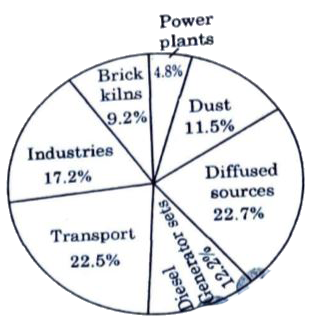
Based on your understanding of the passage choose the correct options :
Select the option that highlights the main idea of the passage.
View SolutionRead the passage given below:
1. Air pollution is a major threat to human health. The United Nations Environment Programme has estimated that, globally, 1.1 billion people breathe in unhealthy air. The World Health Organization (WHO) has estimated that urban air pollution is responsible for approximately 800,000 deaths and 4.6 million people lose their lives every year around the globe.
2. Traffic and transportation problems, inadequate drainage facilities, lack of open spaces, carbon emission, and the accumulation of waste aggravate the problem. Air pollution is associated with increased risk of acute respiratory infections (ARI), the principal cause of infant and child mortality in developing countries.
3. Urban air quality in most mega cities has been found to be critical and Kolkata is no exception to this. An analysis of ambient air quality in Kolkata was done by applying the Exceedance Factor (EF) method where the presence of listed pollutants' (RPM, SPM, `NO_(2)`, and `SO_(2)`) annual average concentration are classified into four different categories, namely critical, high, moderate, and low pollution. Out of a total of 17 ambient air quality monitoring stations operating in Kolkata, five fall under the critical category,and the remaining 12 locations fall under the high category of `NO_(2)` concentration, while for RPM, four record critical, and 13 come under the high pollution category. The causes of high concentration of pollutants in the form of `NO_(2)` and RPM have been identified in earlier studies as vehicular emission (51.4%), followed by industrial sources (24.5%) and dust particles (21.1%).
4. Later, a health assessment was undertaken with a structured questionnaire at some nearby dispensaries which fall under areas with different ambient air pollution levels. Three dispensaries have been surveyed with 100 participants. It shows that respondents with respiratory diseases (85.1 %) have outnumbered waterborne diseases (14.9%) and include acute respiratory infections (ARI) (60%),chronic obstructive pulmonary diseases (COPD) (7.8%), upper track respiratory infection (UTRI) (1.2%), Influenza (12.7%) and acid- fast bacillus (AFB) (3.4%).
5. To live a healthy life and have better well-being practising pollution-averting practies can only be possible when awareness among the masses is generated that the air, they breathe outdoors, is not found to be safe.
Pollution in India
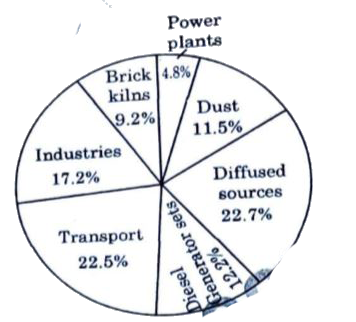
Based on your understanding of the passage choose the correct options :
Select the option that displays the correct 'cause and effect' relationship.
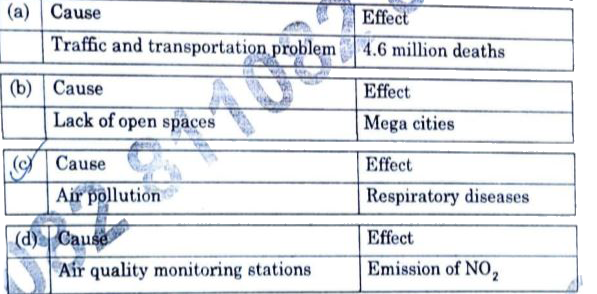
View SolutionRead the passage given below:
1. Air pollution is a major threat to human health. The United Nations Environment Programme has estimated that, globally, 1.1 billion people breathe in unhealthy air. The World Health Organization (WHO) has estimated that urban air pollution is responsible for approximately 800,000 deaths and 4.6 million people lose their lives every year around the globe.
2. Traffic and transportation problems, inadequate drainage facilities, lack of open spaces, carbon emission, and the accumulation of waste aggravate the problem. Air pollution is associated with increased risk of acute respiratory infections (ARI), the principal cause of infant and child mortality in developing countries.
3. Urban air quality in most mega cities has been found to be critical and Kolkata is no exception to this. An analysis of ambient air quality in Kolkata was done by applying the Exceedance Factor (EF) method where the presence of listed pollutants' (RPM, SPM, `NO_(2)`, and `SO_(2)`) annual average concentration are classified into four different categories, namely critical, high, moderate, and low pollution. Out of a total of 17 ambient air quality monitoring stations operating in Kolkata, five fall under the critical category,and the remaining 12 locations fall under the high category of `NO_(2)` concentration, while for RPM, four record critical, and 13 come under the high pollution category. The causes of high concentration of pollutants in the form of `NO_(2)` and RPM have been identified in earlier studies as vehicular emission (51.4%), followed by industrial sources (24.5%) and dust particles (21.1%).
4. Later, a health assessment was undertaken with a structured questionnaire at some nearby dispensaries which fall under areas with different ambient air pollution levels. Three dispensaries have been surveyed with 100 participants. It shows that respondents with respiratory diseases (85.1 %) have outnumbered waterborne diseases (14.9%) and include acute respiratory infections (ARI) (60%),chronic obstructive pulmonary diseases (COPD) (7.8%), upper track respiratory infection (UTRI) (1.2%), Influenza (12.7%) and acid- fast bacillus (AFB) (3.4%).
5. To live a healthy life and have better well-being practising pollution-averting practies can only be possible when awareness among the masses is generated that the air, they breathe outdoors, is not found to be safe.
Pollution in India
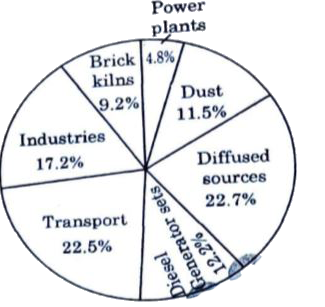
Based on your understanding of the passage choose the correct options :
Read the following statements :
(i) Air pollution kill 4.6 million people every year in India
(ii) Air pollution is causing helath hazards to more people than water pollution.
View SolutionRead the passage given below:
1. Air pollution is a major threat to human health. The United Nations Environment Programme has estimated that, globally, 1.1 billion people breathe in unhealthy air. The World Health Organization (WHO) has estimated that urban air pollution is responsible for approximately 800,000 deaths and 4.6 million people lose their lives every year around the globe.
2. Traffic and transportation problems, inadequate drainage facilities, lack of open spaces, carbon emission, and the accumulation of waste aggravate the problem. Air pollution is associated with increased risk of acute respiratory infections (ARI), the principal cause of infant and child mortality in developing countries.
3. Urban air quality in most mega cities has been found to be critical and Kolkata is no exception to this. An analysis of ambient air quality in Kolkata was done by applying the Exceedance Factor (EF) method where the presence of listed pollutants' (RPM, SPM, `NO_(2)`, and `SO_(2)`) annual average concentration are classified into four different categories, namely critical, high, moderate, and low pollution. Out of a total of 17 ambient air quality monitoring stations operating in Kolkata, five fall under the critical category,and the remaining 12 locations fall under the high category of `NO_(2)` concentration, while for RPM, four record critical, and 13 come under the high pollution category. The causes of high concentration of pollutants in the form of `NO_(2)` and RPM have been identified in earlier studies as vehicular emission (51.4%), followed by industrial sources (24.5%) and dust particles (21.1%).
4. Later, a health assessment was undertaken with a structured questionnaire at some nearby dispensaries which fall under areas with different ambient air pollution levels. Three dispensaries have been surveyed with 100 participants. It shows that respondents with respiratory diseases (85.1 %) have outnumbered waterborne diseases (14.9%) and include acute respiratory infections (ARI) (60%),chronic obstructive pulmonary diseases (COPD) (7.8%), upper track respiratory infection (UTRI) (1.2%), Influenza (12.7%) and acid- fast bacillus (AFB) (3.4%).
5. To live a healthy life and have better well-being practising pollution-averting practies can only be possible when awareness among the masses is generated that the air, they breathe outdoors, is not found to be safe.
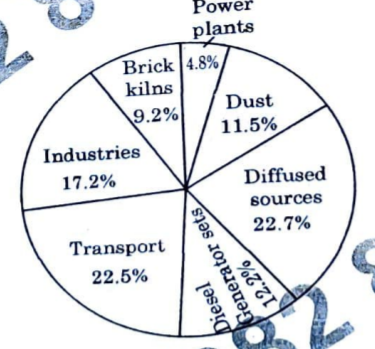
Based on your understanding of the passage choose the correct options :
The author's opinion on the development of Mega cities is
View SolutionRead the passage given below:
1. Air pollution is a major threat to human health. The United Nations Environment Programme has estimated that, globally, 1.1 billion people breathe in unhealthy air. The World Health Organization (WHO) has estimated that urban air pollution is responsible for approximately 800,000 deaths and 4.6 million people lose their lives every year around the globe.
2. Traffic and transportation problems, inadequate drainage facilities, lack of open spaces, carbon emission, and the accumulation of waste aggravate the problem. Air pollution is associated with increased risk of acute respiratory infections (ARI), the principal cause of infant and child mortality in developing countries.
3. Urban air quality in most mega cities has been found to be critical and Kolkata is no exception to this. An analysis of ambient air quality in Kolkata was done by applying the Exceedance Factor (EF) method where the presence of listed pollutants' (RPM, SPM, `NO_(2)`, and `SO_(2)`) annual average concentration are classified into four different categories, namely critical, high, moderate, and low pollution. Out of a total of 17 ambient air quality monitoring stations operating in Kolkata, five fall under the critical category,and the remaining 12 locations fall under the high category of `NO_(2)` concentration, while for RPM, four record critical, and 13 come under the high pollution category. The causes of high concentration of pollutants in the form of `NO_(2)` and RPM have been identified in earlier studies as vehicular emission (51.4%), followed by industrial sources (24.5%) and dust particles (21.1%).
4. Later, a health assessment was undertaken with a structured questionnaire at some nearby dispensaries which fall under areas with different ambient air pollution levels. Three dispensaries have been surveyed with 100 participants. It shows that respondents with respiratory diseases (85.1 %) have outnumbered waterborne diseases (14.9%) and include acute respiratory infections (ARI) (60%),chronic obstructive pulmonary diseases (COPD) (7.8%), upper track respiratory infection (UTRI) (1.2%), Influenza (12.7%) and acid- fast bacillus (AFB) (3.4%).
5. To live a healthy life and have better well-being practising pollution-averting practies can only be possible when awareness among the masses is generated that the air, they breathe outdoors, is not found to be safe.
Pollution in India
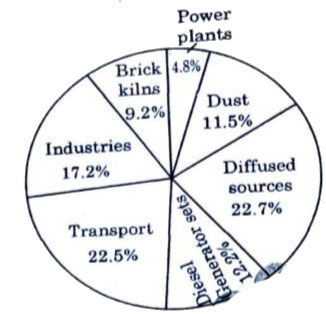
Based on your understanding of the passage choose the correct options :
Select the option that lists the author's recommednation to the people.
i. He wants people to be aware that air pollution is a major threat.
ii. He urges people not to live in mega cities.
iii. He advises people of the follow pollution averting activities seriously.
iv. He wants people to reduce vehicular emissions.
View SolutionRead the passage given below:
1. Air pollution is a major threat to human health. The United Nations Environment Programme has estimated that, globally, 1.1 billion people breathe in unhealthy air. The World Health Organization (WHO) has estimated that urban air pollution is responsible for approximately 800,000 deaths and 4.6 million people lose their lives every year around the globe.
2. Traffic and transportation problems, inadequate drainage facilities, lack of open spaces, carbon emission, and the accumulation of waste aggravate the problem. Air pollution is associated with increased risk of acute respiratory infections (ARI), the principal cause of infant and child mortality in developing countries.
3. Urban air quality in most mega cities has been found to be critical and Kolkata is no exception to this. An analysis of ambient air quality in Kolkata was done by applying the Exceedance Factor (EF) method where the presence of listed pollutants' (RPM, SPM, `NO_(2)`, and `SO_(2)`) annual average concentration are classified into four different categories, namely critical, high, moderate, and low pollution. Out of a total of 17 ambient air quality monitoring stations operating in Kolkata, five fall under the critical category,and the remaining 12 locations fall under the high category of `NO_(2)` concentration, while for RPM, four record critical, and 13 come under the high pollution category. The causes of high concentration of pollutants in the form of `NO_(2)` and RPM have been identified in earlier studies as vehicular emission (51.4%), followed by industrial sources (24.5%) and dust particles (21.1%).
4. Later, a health assessment was undertaken with a structured questionnaire at some nearby dispensaries which fall under areas with different ambient air pollution levels. Three dispensaries have been surveyed with 100 participants. It shows that respondents with respiratory diseases (85.1 %) have outnumbered waterborne diseases (14.9%) and include acute respiratory infections (ARI) (60%),chronic obstructive pulmonary diseases (COPD) (7.8%), upper track respiratory infection (UTRI) (1.2%), Influenza (12.7%) and acid- fast bacillus (AFB) (3.4%).
5. To live a healthy life and have better well-being practising pollution-averting practies can only be possible when awareness among the masses is generated that the air, they breathe outdoors, is not found to be safe.
Pollution in India
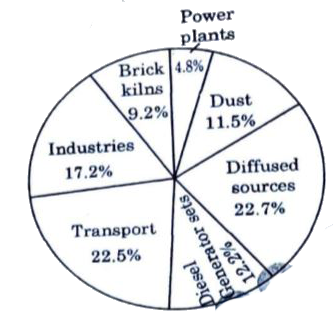
Based on your understanding of the passage choose the correct options :
Select the option that displays the true statement as per fig. 1
View SolutionRead the passage given below:
1. Air pollution is a major threat to human health. The United Nations Environment Programme has estimated that, globally, 1.1 billion people breathe in unhealthy air. The World Health Organization (WHO) has estimated that urban air pollution is responsible for approximately 800,000 deaths and 4.6 million people lose their lives every year around the globe.
2. Traffic and transportation problems, inadequate drainage facilities, lack of open spaces, carbon emission, and the accumulation of waste aggravate the problem. Air pollution is associated with increased risk of acute respiratory infections (ARI), the principal cause of infant and child mortality in developing countries.
3. Urban air quality in most mega cities has been found to be critical and Kolkata is no exception to this. An analysis of ambient air quality in Kolkata was done by applying the Exceedance Factor (EF) method where the presence of listed pollutants' (RPM, SPM, `NO_(2)`, and `SO_(2)`) annual average concentration are classified into four different categories, namely critical, high, moderate, and low pollution. Out of a total of 17 ambient air quality monitoring stations operating in Kolkata, five fall under the critical category,and the remaining 12 locations fall under the high category of `NO_(2)` concentration, while for RPM, four record critical, and 13 come under the high pollution category. The causes of high concentration of pollutants in the form of `NO_(2)` and RPM have been identified in earlier studies as vehicular emission (51.4%), followed by industrial sources (24.5%) and dust particles (21.1%).
4. Later, a health assessment was undertaken with a structured questionnaire at some nearby dispensaries which fall under areas with different ambient air pollution levels. Three dispensaries have been surveyed with 100 participants. It shows that respondents with respiratory diseases (85.1 %) have outnumbered waterborne diseases (14.9%) and include acute respiratory infections (ARI) (60%),chronic obstructive pulmonary diseases (COPD) (7.8%), upper track respiratory infection (UTRI) (1.2%), Influenza (12.7%) and acid- fast bacillus (AFB) (3.4%).
5. To live a healthy life and have better well-being practising pollution-averting practies can only be possible when awareness among the masses is generated that the air, they breathe outdoors, is not found to be safe.
Pollution in India

Based on your understanding of the passage choose the correct options :
As per paragraph 3, select the option that holds true.
View SolutionRead the passage given below:
1. Air pollution is a major threat to human health. The United Nations Environment Programme has estimated that, globally, 1.1 billion people breathe in unhealthy air. The World Health Organization (WHO) has estimated that urban air pollution is responsible for approximately 800,000 deaths and 4.6 million people lose their lives every year around the globe.
2. Traffic and transportation problems, inadequate drainage facilities, lack of open spaces, carbon emission, and the accumulation of waste aggravate the problem. Air pollution is associated with increased risk of acute respiratory infections (ARI), the principal cause of infant and child mortality in developing countries.
3. Urban air quality in most mega cities has been found to be critical and Kolkata is no exception to this. An analysis of ambient air quality in Kolkata was done by applying the Exceedance Factor (EF) method where the presence of listed pollutants' (RPM, SPM, `NO_(2)`, and `SO_(2)`) annual average concentration are classified into four different categories, namely critical, high, moderate, and low pollution. Out of a total of 17 ambient air quality monitoring stations operating in Kolkata, five fall under the critical category,and the remaining 12 locations fall under the high category of `NO_(2)` concentration, while for RPM, four record critical, and 13 come under the high pollution category. The causes of high concentration of pollutants in the form of `NO_(2)` and RPM have been identified in earlier studies as vehicular emission (51.4%), followed by industrial sources (24.5%) and dust particles (21.1%).
4. Later, a health assessment was undertaken with a structured questionnaire at some nearby dispensaries which fall under areas with different ambient air pollution levels. Three dispensaries have been surveyed with 100 participants. It shows that respondents with respiratory diseases (85.1 %) have outnumbered waterborne diseases (14.9%) and include acute respiratory infections (ARI) (60%),chronic obstructive pulmonary diseases (COPD) (7.8%), upper track respiratory infection (UTRI) (1.2%), Influenza (12.7%) and acid- fast bacillus (AFB) (3.4%).
5. To live a healthy life and have better well-being practising pollution-averting practies can only be possible when awareness among the masses is generated that the air, they breathe outdoors, is not found to be safe.
Pollution in India
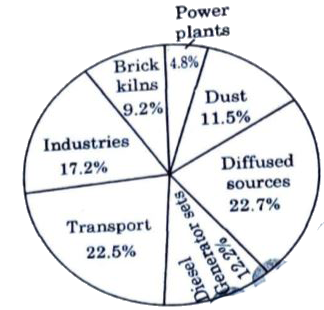
Based on your understanding of the passage choose the correct options :
Read the following statement :
(i) Air quality in Kolkata is less than critical .
(ii) 12 Locations were selected for measuring ambient air quality.
(iii) Most of the mega cities are suffering from the problem of poor air quality.
View SolutionRead the passage given below:
1. Air pollution is a major threat to human health. The United Nations Environment Programme has estimated that, globally, 1.1 billion people breathe in unhealthy air. The World Health Organization (WHO) has estimated that urban air pollution is responsible for approximately 800,000 deaths and 4.6 million people lose their lives every year around the globe.
2. Traffic and transportation problems, inadequate drainage facilities, lack of open spaces, carbon emission, and the accumulation of waste aggravate the problem. Air pollution is associated with increased risk of acute respiratory infections (ARI), the principal cause of infant and child mortality in developing countries.
3. Urban air quality in most mega cities has been found to be critical and Kolkata is no exception to this. An analysis of ambient air quality in Kolkata was done by applying the Exceedance Factor (EF) method where the presence of listed pollutants' (RPM, SPM, `NO_(2)`, and `SO_(2)`) annual average concentration are classified into four different categories, namely critical, high, moderate, and low pollution. Out of a total of 17 ambient air quality monitoring stations operating in Kolkata, five fall under the critical category,and the remaining 12 locations fall under the high category of `NO_(2)` concentration, while for RPM, four record critical, and 13 come under the high pollution category. The causes of high concentration of pollutants in the form of `NO_(2)` and RPM have been identified in earlier studies as vehicular emission (51.4%), followed by industrial sources (24.5%) and dust particles (21.1%).
4. Later, a health assessment was undertaken with a structured questionnaire at some nearby dispensaries which fall under areas with different ambient air pollution levels. Three dispensaries have been surveyed with 100 participants. It shows that respondents with respiratory diseases (85.1 %) have outnumbered waterborne diseases (14.9%) and include acute respiratory infections (ARI) (60%),chronic obstructive pulmonary diseases (COPD) (7.8%), upper track respiratory infection (UTRI) (1.2%), Influenza (12.7%) and acid- fast bacillus (AFB) (3.4%).
5. To live a healthy life and have better well-being practising pollution-averting practies can only be possible when awareness among the masses is generated that the air, they breathe outdoors, is not found to be safe.
Pollution in India
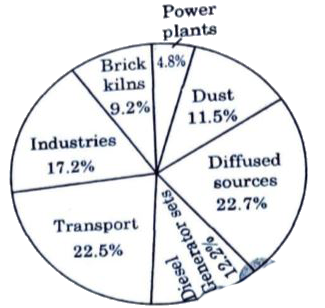
Based on your understanding of the passage choose the correct options :
"accumulation of waste aggrrvates the problem".
Select the option that best describes the problem with reference to the above statement .
View Solution
SECTION-A (READING) questions and complete solutions for chapter QUESTION PAPER 2022 TERM 1 SET 1 of XII BOARDS PREVIOUS YEAR of Class 12